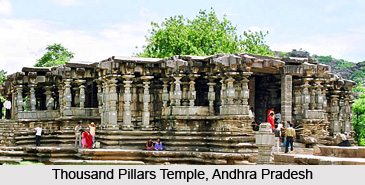Thousand Pillars Temple is a notable, historical Hindu temple dedicated to Lord Surya, Lord Vishnu and Lord Shiva and is situated in Hanamakonda town near Warangal, Andhra Pradesh. Presently, the temple is being maintained and preserved by the Archaeological Survey of India and one will notice beautiful lawns surrounding the Thousand Pillars Temple. As suggested by its name, the temple is smartly supported with the aide of a thousand pillars and it was built during 1163 AD by Rudra Deva, a Kakatiya king. The Thousand Pillars Temple was also termed as `Sri Rudreshwara Swamy Temple`, in the honour of the Kakatiya ruler who erected it. The temple lies at a distance of nearly 150 kms away from Hyderabad.
History of Thousand Pillars Temple
The Thousand Pillars Temple is a spectacular Indian temple created in 1163 AD and is considered to be one of the greatest architectural grandeur, a product of the efforts and expertise of the Kakatiya Vishwakarma `sthapatis` or artisans. The temple had been demolished by the rulers of Tughlaq Dynasty when they invaded southern India and it comprises a singular temple and other buildings.
 The presence of a thousand pillars in the temple never prevents its visitors from viewing the idol of the deity in the other temple. Currently, the pillars of Thousand Pillars Temple have been extricated by engineers who have discovered a gigantic mass of sand underneath all the pillars. It was wet sand which had accumulated due to a pipe connection whose source was a local water-body called `Bhadrakali Cheruvu`.
The presence of a thousand pillars in the temple never prevents its visitors from viewing the idol of the deity in the other temple. Currently, the pillars of Thousand Pillars Temple have been extricated by engineers who have discovered a gigantic mass of sand underneath all the pillars. It was wet sand which had accumulated due to a pipe connection whose source was a local water-body called `Bhadrakali Cheruvu`.
Architecture of Thousand Pillars Temple
This star-shaped temple is equipped with Shiva lingams and numerable shrines and the three shrines located inside the temple premises is known as the `Trikutalayam`. A large garden flanks the Thousand Pillars Temple which possesses certain tiny lingam shrines. A statue of a `Nandi` bull carved out from black basalt monolith, which has been highly polished adorns the interiors of the temple, along with it`s artistically carved out 1000 pillars. The temple is based on a one metre high platform. Rock-cut elephant figures and perforated screens add to the aesthetic appeal of the temple. `Rudreshwar` or Lord Shiva is the presiding deity of this temple whose idol is placed in the `Garbha Griha` or sanctum sanctorum. The four central pillars, ceiling stabs and the outer walls of the temple are beautifully adorned with finely carved sculptures. The sculptures of Lord Indra riding his elephant Airavata display the excellent and unique craftsmanship of the Kakatiya Dynasty.











